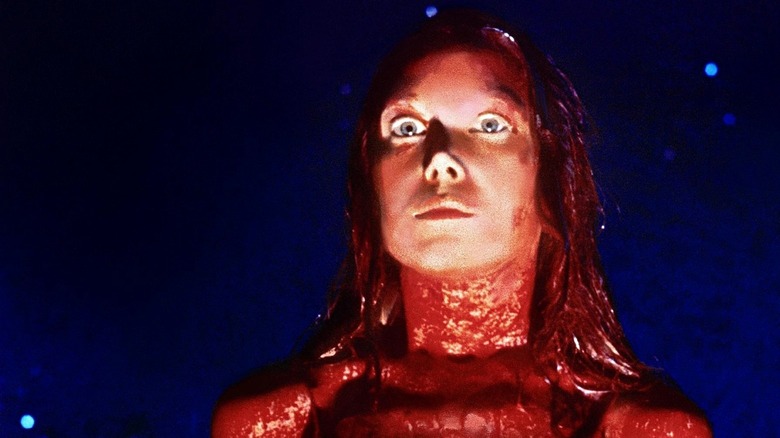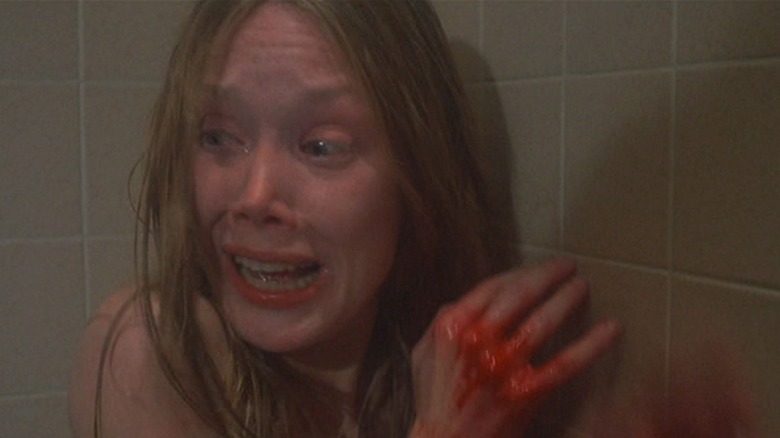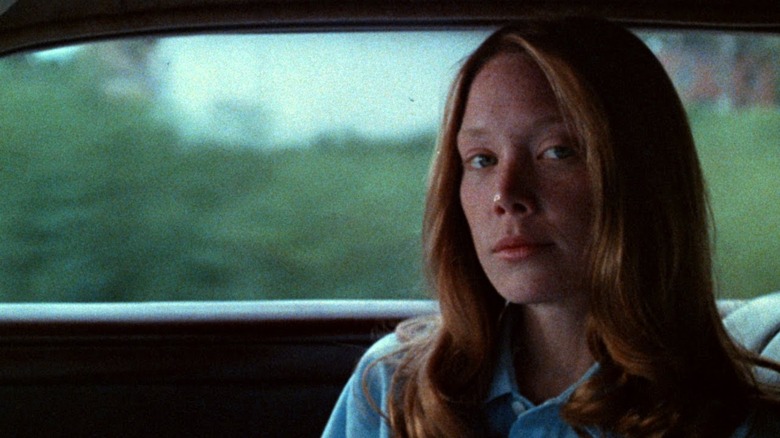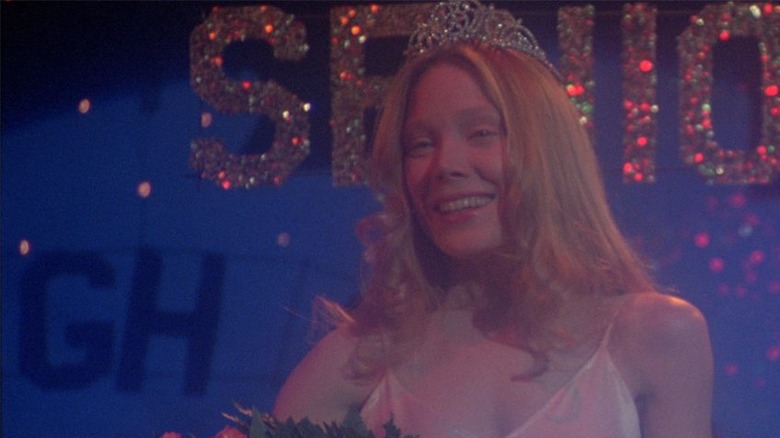How Sissy Spacek Convinced Brian De Palma To Give Her The Role Of Carrie
1976's "Carrie" climaxes with an unforgettable image — the one that got put on all the posters — of Sissy Spacek in a prom dress covered in blood. The best qualities of director Brian De Palma, master of erotic and lurid suspense (and a Hitchcock heir), come together in that moment. He builds up to it slowly and then releases, with buckets of pig blood dropping onto the film's protagonist. De Palma's been accused of cruelty, sadism, and misogyny, but in his best movies, those are a surface-level sheen over the more substantial story underneath. In this case, part of the terror of the image is the result of what Spacek brings to it: her own portrayal of the main character's haunted and battered inner life.
De Palma may not have made the cut as Stephen King's favorite collaborator, but when he made "Carrie," an adaptation of King's first novel, the result was a '70s horror classic that explores eternal themes. For De Palma, the story of Carrie White (Spacek) was one about a very specific kind of teenage anxiety, the loneliness of small-town life, and bullying, both at home and at school. Balancing the movie out is a central performance that is almost anti-movie star, the opposite of glamorous, as Spacek commits to the reality of the lead role with terrifying, heartbreaking sincerity. That strength is what makes the story of her unconventional method of getting the role even better in retrospect.
Awkward teens
Spacek was in her mid-20s when she played the teenaged Carrie, an awkward, introverted girl with a staunchly religious, abusive mother (Piper Laurie, who famously played the role like a comedy) and blooming telekinetic powers. She has a hard time making friends, and only finds comfort from gym teacher Miss Collins (Betty Buckley). When she unexpectedly has her first period in the locker room shower, her classmates bully her and her mom locks her in her "prayer closet," setting off a chain of events that will result in a lot of bloodshed.
That Carrie is decidedly not the villain of the film, but rather an almost supernatural force responding to the brutal way she's treated, plays nicely with the monster movie tradition. You feel for Carrie before anything else — her acute sense of isolation and victimhood takes up much of the first half of the movie, and it lingers well into the prom night climax. A more conventional actress might have been able to play the shy, quiet side of Carrie, but few could have brought her pain to life like Spacek.
Spacek in the industry
By 1976, Spacek had been in the entertainment industry for nearly 10 years. After a brief singing career, she moved into acting, getting attention early on with Terrence Malick's 1973 directorial debut, "Badlands." In that movie, she played a cold-hearted teen serial killer on the run with her older boyfriend (Martin Sheen), a role that could easily have been sensationalistic. Instead, she played it wide-eyed, romantic, like a girl who's getting swept wholeheartedly into a fairy tale romance. While making "Badlands," she met production designer Jack Fisk, and the two were married by the next year.
Fisk got hired not long after to design Brian De Palma's 1974 film "Phantom of the Paradise," and he brought Spacek along with him to do set decoration. To De Palma, Spacek wasn't an actress, but, in her own words to ComingSoon.net, "a very awful set decorator." He didn't think much of her as an actor either. While she languished in the long audition process for "Carrie," De Palma even encouraged her to take a commercial gig she'd been offered.
Nevertheless, Spacek was determined, and De Palma's lack of enthusiasm around her amplified that. Spacek recounted to ComingSoon.net that she "went all out all method actress style" to prepare for her screen test:
"I had rubbed Vaseline into my hair to make it all greasy and yucky, I didn't brush my teeth ... I had a little dress that I had had since junior high school that was all ratty and old and when the hair and make up people saw me coming, they raced to me to fix me up and I was like, 'No! Stay away!' then I raced over to a corner and sulked and got ready for my screen test."
Winning the role
She got the role.
Watching the dailies, De Palma knew he was getting a strong performance from Spacek, who brought a lived-in reality to the character. Spacek didn't even hang out with the rest of the cast between scenes, another choice that became part of the character. When Carrie starts to get charmed by the popular kids, who plan on pranking her at the prom, you get a sense of the hope she feels just by looking at Spacek's eyes. And the alien posture she adopts when her powers take hold of her at the movie's end makes for a horrifying physical transition.
Spacek's degree of commitment, and her willingness to get dirty for the audition, were necessary. It's difficult to imagine what the movie could have been like without Spacek, let alone the rest of the movie's prodigious cast and crew. While De Palma's typical pyrotechnics still dazzle even now, the movie's performances, from Amy Irving as sympathetic mean girl Sue Snell to the Oscar-nominated Spacek and Laurie, are what give the film its long-lasting power. They also help make it a horror movie that was worthy of winning best picture.



